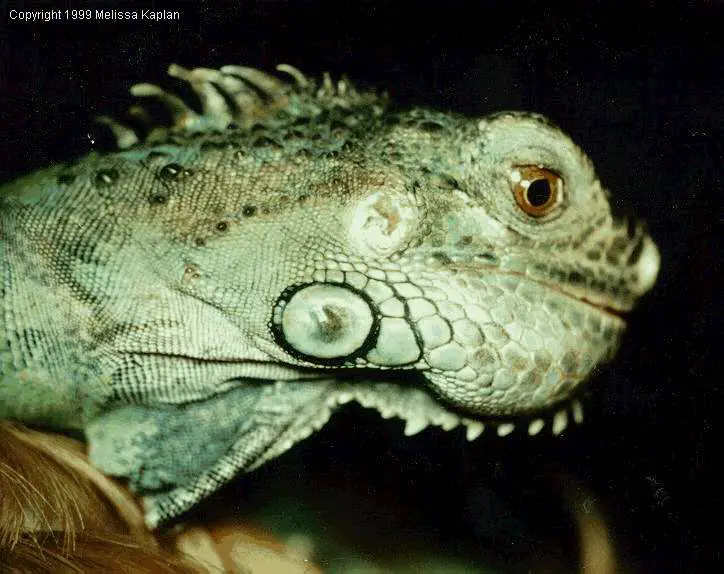The green iguana (Iguana iguana) is the world’s largest iguana species; grows to a length of about 2 meters. It is found in South America, Central America and Caribbean. The lizard is calm and quite which is why it makes very good pets. However in captivity iguanas can be demanding and must be challenging for true owners. Green iguanas are fairly common on the Caribbean Islands. They are also called ‘common iguana’, ‘American iguana’, or simply ‘iguana’.
Green Iguana Facts
Anatomy
- The head and body length of adult iguanas is 1.2 to 1.7 m (3.9 to 5.6 ft) with the tail measuring about 30 to 42 cm (12 to 17 in).
- Adult males typically weigh up to 4 kg (8.8 lb) while the females average 1.2 to 3 kg (2.6 to 6.6 lb) in weight.
- The heaviest of the specimen can reach the size of 2 m (6.6 ft) with the weight of about 6 to 8 kg (13 to 18 lb).
- Depending on the location, green iguanas appear to show different colors. Iguanas living in Peru are recognized by their bluish appearance while those inhabiting islands of Aruba, Grenada, Bonaire, and Curacao are likely to show greenish to black body with some pink markings on it.
- Green iguanas living in the Costa Rica have reddish orange body.
- Young iguanas are bluish bright in color but it fades away as they get older.
- Iguanas of St. Lucia are thought to possess light green skin with the prominent black stripes.
- They have creamy white eyes. American iguanas have scales on the back that starts from the head all the way to the tail. The scales on the back of the head are comparatively smaller. These scales serve as a defense against potential predators.
- Green iguanas are able to strike with their whip-like tail. If you hold it from its tail, iguanas may detach the tail and escape. After sometime it will grow a new tail.
- They possess remarkable sense of sight—ability to recognize things from long distances. Iguanas may also sense any motion or shapes from far-off. Nevertheless, under low-light conditions they have a poor vision.
- The green iguana’s eyes are unable to form images but they respond actively to any change in light or to any movement. Thanks to the acute vision, iguanas can easily sense predators.

Distribution & Habitat
- Green iguanas occur in the central Brazil, Bolivia, Trinidad and Tobago, St. Lucia, St. Vincent, and Útila. They are not the native species of United States. Green iguanas have been introduced to South Florida, U.S. Virgin Islands, Hawaii, Texas (Rio Grande Valley).
- They make habitats (near water) during the day when they are most active. Iguanas are arboreal species for they can climb trees to a height of about 50 feet (15 m) and may also fall on land unhurt. Sometimes on their way down iguanas also get hold of branches with hind legs to reduce the falling speed.
- In the rainy season, green iguanas spend more time on land to seek warmth.
Behavior
- Studies show that adult males have powerful jaws and as such they are more likely to be aggressive than females.
- Unlike females, adult males actively defend territories against outsiders. Besides they are thought to attract more females.
- Green iguanas generally avoid predators inasmuch as they can and will often dive into the nearby water if they see one. However if they’re provoked iguanas may not hesitate to bob its head or display the dewlap under its neck to drive the predator off. If the predator doesn’t run away, then probably iguana uses its claws or even whip it with a tail.
- They use tail to swim and submerge its entire body while propelling.

Feeding Ecology & Diet
- Green iguanas have herbivorous diet. They have got sharp teeth—perfect for ripping off the leaves but it can also cut human skin.
- Green iguana’s diet consists of mustard greens, flowers, fruit, growing shoots, turnip greens, and dandelion greens. They eat shoots from 100 different plants species. In the wild, green iguanas also consume grasshoppers or tree snails but they only do so in order to supplement their diet.
- They may also feed on bird’s eggs but iguanas don’t seem to prefer too much protein for protein-rich diet is hard to digest.
- Prominent among the green matter is wild plum Spondias mombin which is the favorite food for iguanas living in Panama.
- In captivity, they would like to eat collards, acorn squash, parsnip, butternut squash, iceberg lettuce, and mango.
Reproductive Biology
- A female green iguana may lay as many as 60 eggs in one time.
- None of the parents guard the eggs in the nest. Adult males however protect females from predators.
- Green iguanas often share their nesting sites with American crocodiles.
- The incubation period lasts about 10 – 15 days.






Leave a Reply